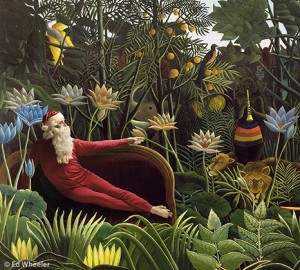Take Five: Artist Ed Wheeler Incorporates Santa into Classical Paintings
Christmas may be long over, but artist Ed Wheeler keeps the spirit of the holiday alive all year long by incorporating Santa into the great masterworks of art. Taking such classics as The Supper at Emmaus by Caravaggio or The Dream by Henri Rousseau, Wheeler dresses up as Santa and integrates himself into the piece through photography (a multi-step process), often replacing a key figure in the chosen painting. The end result is nothing short of amusing and marvelous, due to the attention to detail that is given to each piece, from the lighting and brushstrokes to the colors and composition, making it look impeccably close to the original.
Wanting to share his works with people of all ages, Wheeler took to the Internet and created a blog as well as Web site specifically dedicated to his Santa Classics. But the Internet blogosphere and media sites weren’t the only ones that took notice of Wheeler’s humorous take on the masterpieces — the Philadelphia Museum of Art was equally impressed. Taking 11 of his diverse works, the Philadelphia Museum of Art became one of the first to publish a set of Santa Classics cards in October 2013. Soon after, this led to a two-week exhibit at the Bahdeebahdu studio in Philadelphia. Needless to say, for the Santa enthusiast, the act of simply creating a once-a-year holiday card for friends and family was now a thing of the past, turning into a full-time hobby.
Taking a moment away from his newest additions, Wheeler discussed his fascination with light, the process behind creating a Santa Classics piece, and his reasoning behind starting this series in the first place.
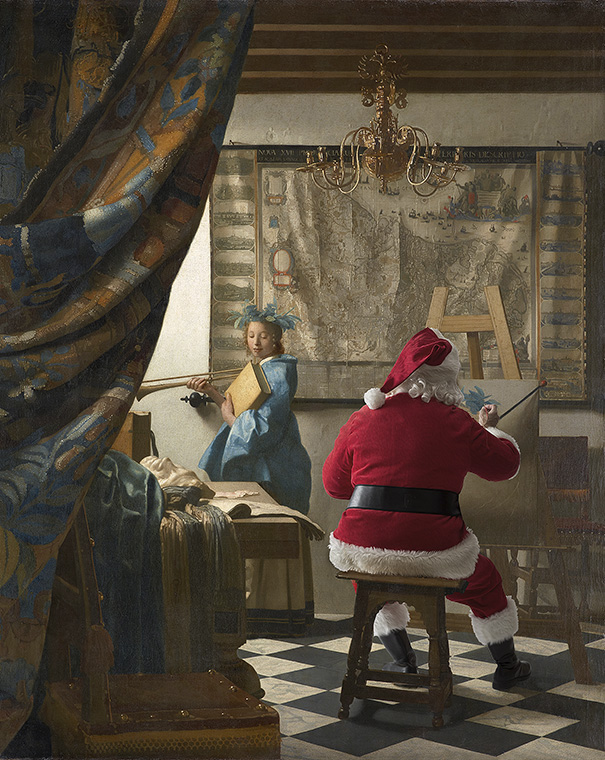
A rendition of Johannes Vermeer’s painting “The Art of Painting” by artist Ed Wheeler. Photo Credit: Ed Wheeler.
GALO: Your Web site states that your intention behind your project (or as you refer to it, the “Santa intervention”) stems from making people smile. When did you first come up with the idea of placing Santa Claus in classical paintings, and was there any other reason for this particular endeavor?
Ed Wheeler: I have been dressing up as Santa and doing self-portraits for 25 years. It started as a once-a-year project that I would send as a Christmas card for friends and clients. (For 35 years I have worked as a professional photographer.) Three years ago, while viewing Washington Crossing the Delaware painted by Leutze at the Metropolitan Museum of Art, I thought how much fun it would be to incorporate Santa into the great works of art history. I have been fascinated by the Santa character since I was a child. He is a symbol of joy, love and kindness, all of the good things in life. He’s the symbol of gift giving and the love of children all over the world. I have been collecting Santas most of my adult life. My Christmas tree is adorned by nothing but Santa ornaments.
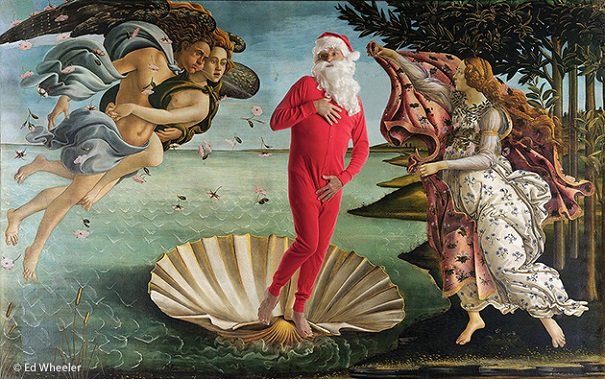
A rendition of Sandro Botticelli’s painting “The Birth of Venus” by artist Ed Wheeler. Photo Credit: Ed Wheeler.
GALO: For the Philadelphia Museum of Art, you had created 11 different holiday cards in which you had incorporated a photograph of yourself dressed as Santa into classic images. Do you dress up for all of the images you create on your site, and, if so, why do you prefer being in the painting rather than using a stock image or photographing someone else?
EW: All of the images on my Santa Classics Web site involve me dressed as Santa. I also have a commercial website (www.edwheeler.com), where I display photos of my corporate clients. When I first started creating Santa photos 30 years ago, I had friends dress up as the old elf, but then I realized how much fun it was and I decided to give it a try. I dress as Santa for the Classics simply for the fun of it, and the additional challenge. It is very difficult to model for some of the paintings. I cannot imagine how a person could hold some of those poses long enough to be painted.
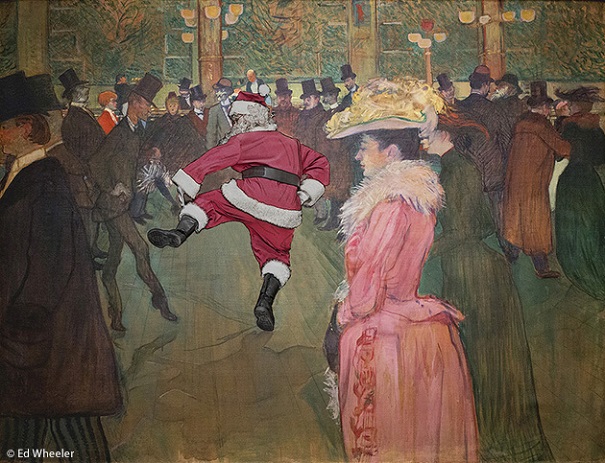
A rendition of Henri de Toulouse-Lautrec’s painting “At the Moulin Rouge” by artist Ed Wheeler. Photo Credit: Ed Wheeler.
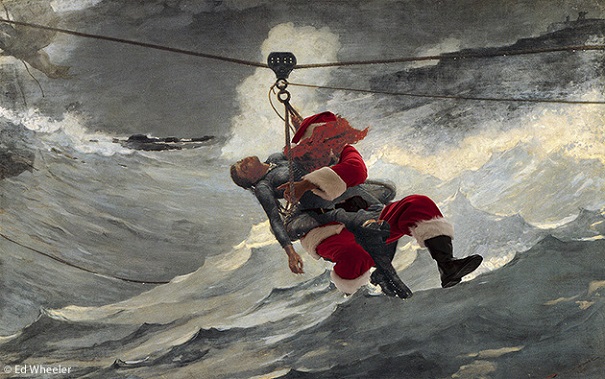
A rendition of Winslow Homer’s painting “The Life Line” by artist Ed Wheeler. Photo Credit: Ed Wheeler.
GALO: You seem to be quite fascinated by light such as in the painting Carnival or Supper at Emmaus. Can you tell us where this fascination stems from? We all know that light plays a key role in photography and the way an image appears is largely dependent upon its luminosity.
EW: The etymology of photography means drawing with light. For the first 25 years of my career, all of my personal work and much of my commercial work was in black and white. In that medium, the driving factor is the light. There is no color to intensify the image. My ability to see and feel the light was a requirement for success. When I look at a painting, I always consider how the artist has used light to bring out the characters. It doesn’t matter if it is a Caravaggio allegory or a Bierstadt landscape; the light takes your breath away.
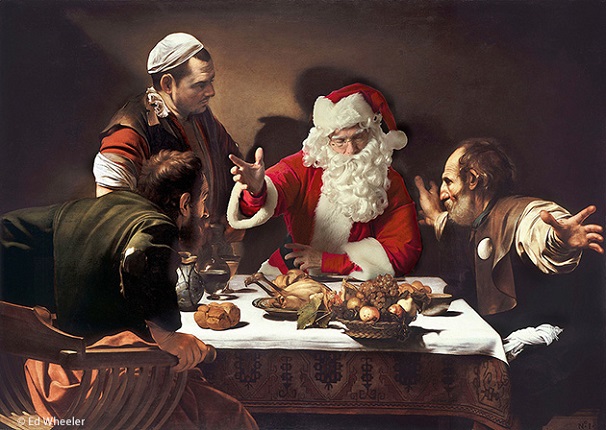
A rendition of Caravaggio’s painting “Supper at Emmaus” by artist Ed Wheeler. Photo Credit: Ed Wheeler.
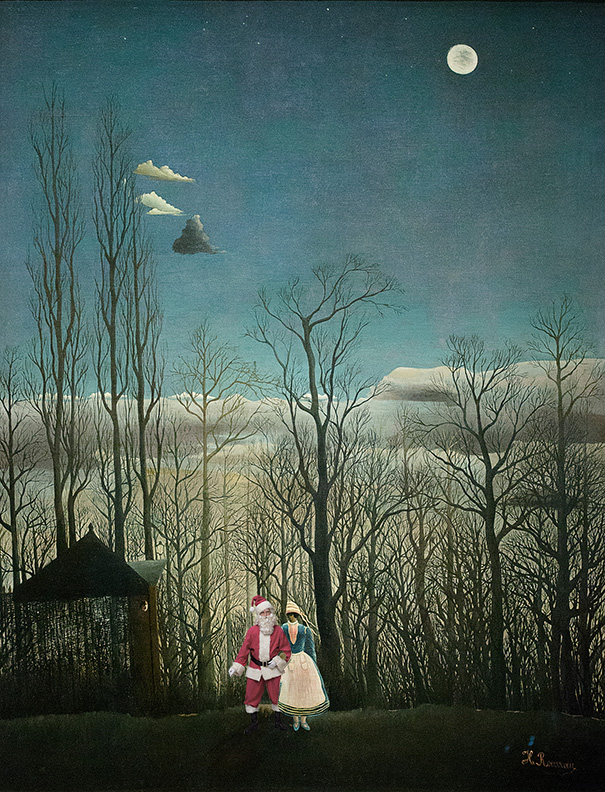
A rendition of Henri Rousseau’s painting “Carnival Evening” by artist Ed Wheeler. Photo Credit: Ed Wheeler.
GALO: Your choices in paintings, or rather the scenes they depict, range from the dramatic, to the historical, to the romantic. How do you go about choosing the classical paintings for your recreations?
EW: Most of the time, I choose a painting because I think that Santa’s presence would illicit humor. Sometimes, I think that his presence will send a message. Sometimes, I just love the painting so much that I figure a way to incorporate Santa so that he can be part of it.
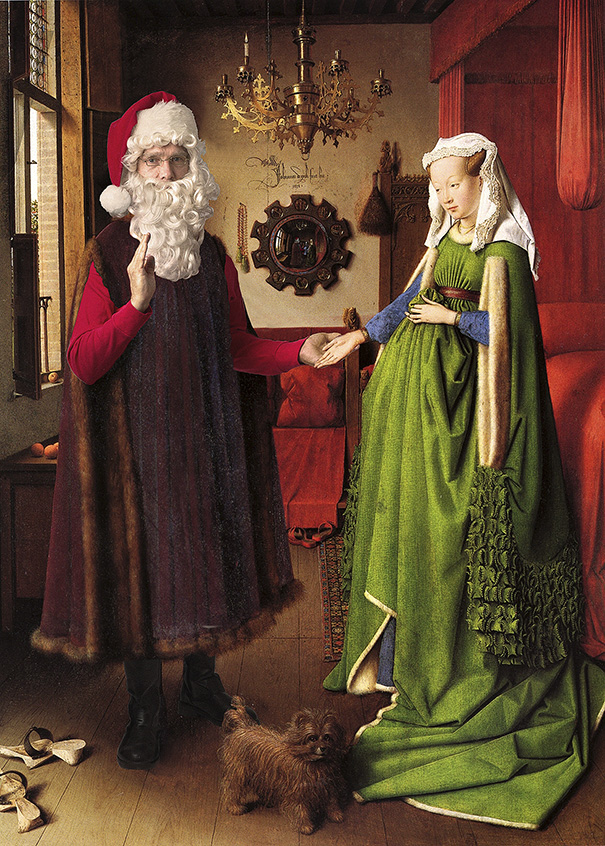
A rendition of Jan van Eyck’s “Arnolfini Portrait” by artist Ed Wheeler. Photo Credit: Ed Wheeler.
GALO: How do you envision this series a year from now — do you plan to further develop it with additional characters, or perhaps by incorporating the Santa figure in other times in art history, such as in the Pop Art movement?
EW: I am not sure where the series will be a year from now. I am working with my wife, Alina, who is a designer/author and my muse to develop new ideas. I know there will be more Classics. I started work on three new ones yesterday. And I know Santa will always be the character. There will be no others.
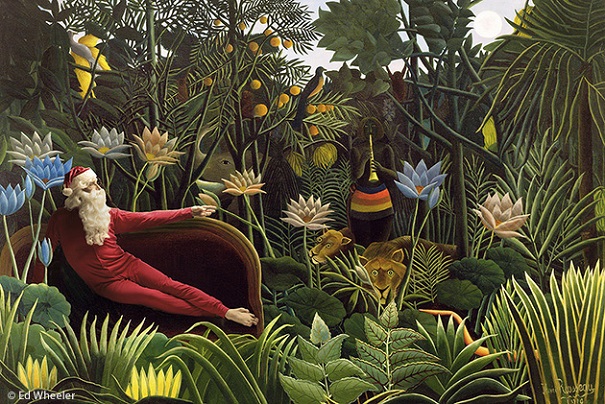
A rendition of Henri Rousseau’s painting “The Dream” by artist Ed Wheeler. Photo Credit: Ed Wheeler.
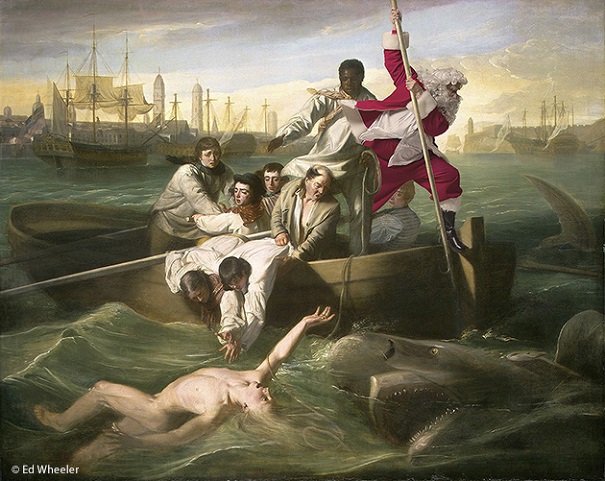
A rendition of John Singleton Copley’s painting “Watson and the Shark” by artist Ed Wheeler. Photo Credit: Ed Wheeler.
For more information about Ed Wheeler’s ongoing work, please visit http://www.santaclassics.com/.

